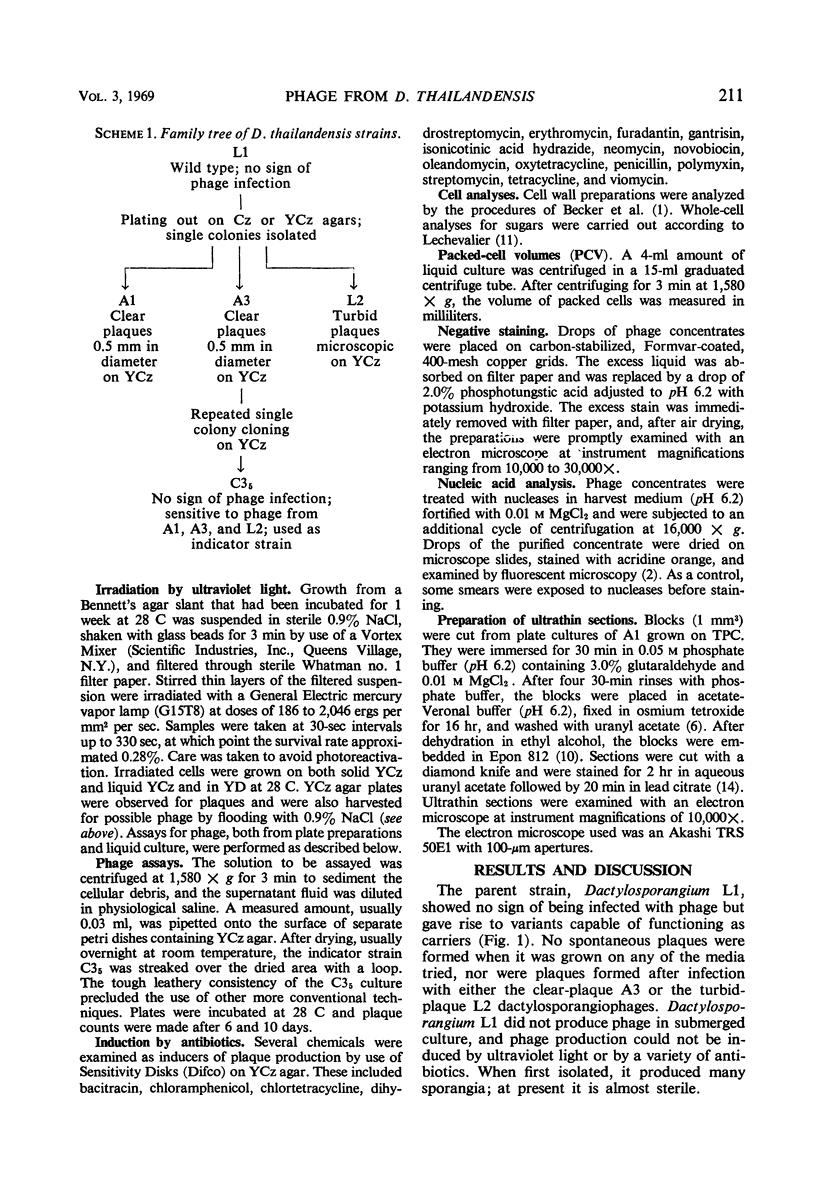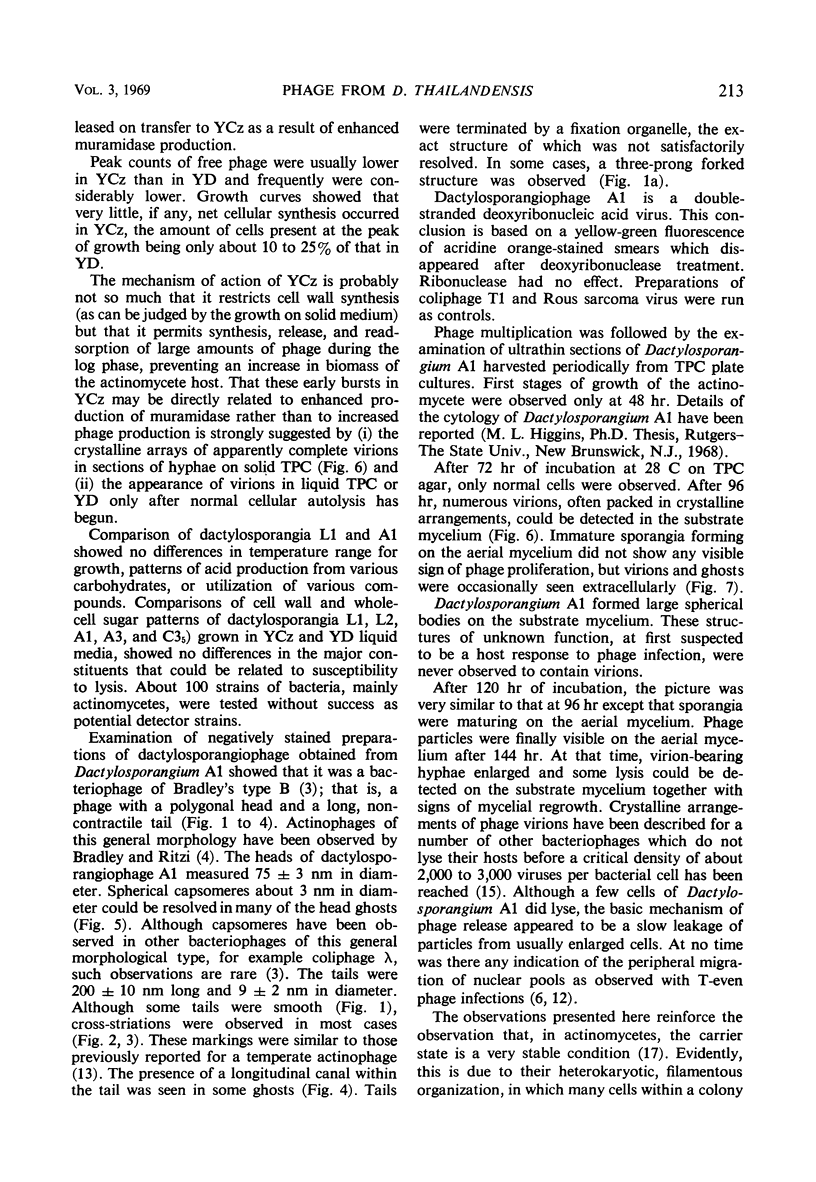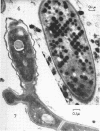Abstract
Dactylosporangiophage A1 has a polygonal head (75 nm) with spherical capsomeres (3 nm) and a noncontractile tail (200 by 10 nm) with cross-striations which is terminated with at least three prongs which are used for attachment. It contains double-stranded deoxyribonucleic acid and produces very little lysis. Intracellular phage multiplication leads to the formation of crystalline aggregates of apparently complete virions. Plaques are formed only on certain substrains of Dactylosporangium thailandensis L1 and are always small (0.5 mm or less). They are clear on some substrains and turbid on others. Formation of plaques occurs only on one medium, Czapek agar with 0.2 to 0.4% yeast extract, 0.2% peptone, or a defined mixture of amino acids. Over 100 strains of bacteria, mainly actinomycetes, were screened in a futile attempt to find an indicator strain which is not a substrain of L1. The Dactylosporangium-phage system studied is considered to be a semiresistant carrier state.
Full text
PDF






Images in this article
Selected References
These references are in PubMed. This may not be the complete list of references from this article.
- BECKER B., LECHEVALIER M. P., LECHEVALIER H. A. CHEMICAL COMPOSITION OF CELL-WALL PREPARATIONS FROM STRAINS OF VARIOUS FORM-GENERA OF AEROBIC ACTINOMYCETES. Appl Microbiol. 1965 Mar;13:236–243. doi: 10.1128/am.13.2.236-243.1965. [DOI] [PMC free article] [PubMed] [Google Scholar]
- Bradley D. E. Ultrastructure of bacteriophage and bacteriocins. Bacteriol Rev. 1967 Dec;31(4):230–314. doi: 10.1128/br.31.4.230-314.1967. [DOI] [PMC free article] [PubMed] [Google Scholar]
- Higgins M. L., Lechevalier M. P., Lechevalier H. A. Flagellated actinomycetes. J Bacteriol. 1967 Apr;93(4):1446–1451. doi: 10.1128/jb.93.4.1446-1451.1967. [DOI] [PMC free article] [PubMed] [Google Scholar]
- Kolstad R. A., Bradley S. G. Purification of Streptomyces venezuelae phage. J Bacteriol. 1964 May;87(5):1157–1161. doi: 10.1128/jb.87.5.1157-1161.1964. [DOI] [PMC free article] [PubMed] [Google Scholar]
- Lechevalier H. A., Lechevalier M. P. Biology of actinomycetes. Annu Rev Microbiol. 1967;21:71–100. doi: 10.1146/annurev.mi.21.100167.000443. [DOI] [PubMed] [Google Scholar]
- Lechevalier H. A., Lechevalier M. P., Holbert P. E. Electron microscopic observation of the sporangial structure of strains of Actinoplanaceae. J Bacteriol. 1966 Oct;92(4):1228–1235. doi: 10.1128/jb.92.4.1228-1235.1966. [DOI] [PMC free article] [PubMed] [Google Scholar]
- Lechevalier H., Lechevalier M. P., Higgins M. L. Les actinomycétes mobiles et leurs phages. Laval Med. 1968 Sep;39(7):621–625. [PubMed] [Google Scholar]
- Lechevalier M. P. Identification of aerobic actinomycetes of clinical importance. J Lab Clin Med. 1968 Jun;71(6):934–944. [PubMed] [Google Scholar]
- Margaretten W., Morgan C., Rosenkranz H. S., Rose H. M. Effect of hydroxyurea on virus development. I. Electron microscopic study of the effect on the development of bacteriophage T4. J Bacteriol. 1966 Feb;91(2):823–833. doi: 10.1128/jb.91.2.823-833.1966. [DOI] [PMC free article] [PubMed] [Google Scholar]
- REYNOLDS E. S. The use of lead citrate at high pH as an electron-opaque stain in electron microscopy. J Cell Biol. 1963 Apr;17:208–212. doi: 10.1083/jcb.17.1.208. [DOI] [PMC free article] [PubMed] [Google Scholar]
- Thiemann J. E., Pagani H., Beretta G. A new genus of the actinoplanaceae: dactylosporanguim, gen. nov. Arch Mikrobiol. 1967;58(1):42–52. doi: 10.1007/BF00691167. [DOI] [PubMed] [Google Scholar]
- WELSCH M. The behaviour towards actinophage of mutants surviving its lytic action. Antonie Van Leeuwenhoek. 1957;23(1):59–80. doi: 10.1007/BF02545859. [DOI] [PubMed] [Google Scholar]




